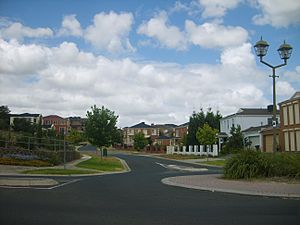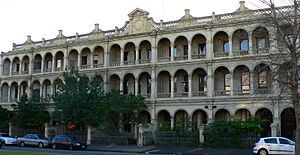Housing in Victoria, Australia facts for kids
In the Australian state of Victoria, most people own their homes. There isn't much public housing, which is housing provided by the government to help people. Also, it can be hard to find a place to rent, and often, it's quite expensive.
About 70% of Victoria's population lives in Melbourne. Outside of Melbourne, homes and rent are usually cheaper. In Melbourne, it might be a bit easier to get public housing, but homes and rent are generally more expensive.
The Victorian state government usually provides public housing. Both the Australian national government and the Victorian state government help pay for these homes.
Right now, Victoria and Melbourne are growing fast. This means more people need homes, which makes housing prices go up. It also affects how much rent costs and how many homes are available.
Contents
Renting a Home
It's currently quite hard to find a rental home in Victoria because many people are looking for one. This is due to the fast growth in population. Finding a rental that you can afford can be especially tricky. Sometimes, people looking for a home offer to pay more rent or pay several months of rent in advance to try and get the place. There are currently no rules in Victoria that limit how much landlords can charge for rent.
How Housing Changed Over Time
The way homes were built in Victoria often depended on how people travelled at the time. In older parts of Melbourne and some regional towns, built in the late 1800s, it's easy to get around using public transport like trains, trams, and buses. There are also good paths for cycling.
However, in newer suburbs and outer areas of Melbourne and regional towns, built in the 1900s, people mostly rely on cars. There isn't much public transport.
This difference in transport affects many things about housing in Victoria. For example, homes are often more expensive where there's good public transport and other helpful services. Areas with good transport and services are often where more well-off people live, and these areas can become more popular and expensive. Outer suburbs are usually cheaper but have less access to good public transport and services.
Types of Homes
Most homes in Victoria are single or double-storey houses that stand on their own. They usually have living areas like a family room, a dining room, a garage, a front or back yard, and a driveway.
In inner Melbourne and some older parts of regional towns, you'll find homes that are closer together, like terrace houses. These can be different sizes and have different numbers of levels, depending on how wealthy the area was in the past.
In inner Melbourne and some other areas, there are also many apartment buildings. Some older apartment blocks, built in the 1960s and 1970s, are very common in Melbourne's older inner suburbs. Many larger apartment buildings were built in Melbourne during the 1990s and 2000s.
Help for People with Housing
If people need help with housing in Victoria, there are a few places they can go. These include groups like Tenants Unions, which help renters. There are also government groups like the Victorian Civil and Administrative Tribunal, which helps solve disagreements. People can also get financial help like 'Rent Assistance' through a government service called Centrelink.
Images for kids
-
A public housing high rise in Collingwood, Melbourne




